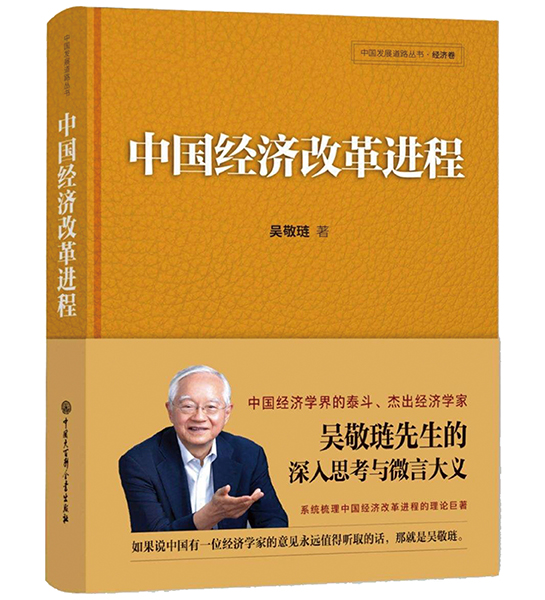Wu Jinglian: An Analysis of China’s Economic Reform and Opening-up

Wu Jinglian is Honorary Professor of China Europe International Business School (CEIBS)
This is an edited version of the foreword to The Progress of China’s Economic Reform and Opening-up
“China’s current economic problems, that need to be resolved, can be traced back to their origins of the past 40 years.”
~ Wu Jinglian
 Since the late 1970s, China’s reform and opening-up has covered a period of nearly 40 years. This reform and opening-up has brought dramatic changes to the country’s social and economic life, and in 2010 made China the second largest economy. The Progress of China’s Economic Reform and Opening-up tries to give a brief introduction and analysis of the turbulent historical course of China’s reform and opening-up.
Since the late 1970s, China’s reform and opening-up has covered a period of nearly 40 years. This reform and opening-up has brought dramatic changes to the country’s social and economic life, and in 2010 made China the second largest economy. The Progress of China’s Economic Reform and Opening-up tries to give a brief introduction and analysis of the turbulent historical course of China’s reform and opening-up.
In my view, the factor most crucial to boosting China’s economy is that the market’s expansion has provided a certain degree of room for individuals and enterprises to exert their right to choose. Despite the many restraints that still exist, compared to the period before the reform and opening-up, people have obtained an unprecedented right of free choice in terms of enterprises’ scheduling of production and setting of selling price as well as individual’s offering of their labour and choices they make in consumption of commodities and services. This expansion of the market-oriented right of free choice has provided prime conditions for the effective combination of labour, capital and technology in this particular time and space, so that the increased potential of China’s economy is greatly released.
In this sense, the course of China’s economic reform and opening-up can be defined as one that the market expands continuously – both in terms of region and scale. However, the market does not arise and expand without obstacles in the historical context of a planned economy. The view that considers China’s reform and opening-up as a policy option based on the economic rationality of Pareto optimization, is merely an overly simplified description of the course of China’s reform and opening-up. This is because it hasn’t explained what made the careful reopening of the market under the heavy burden of the planned economy; neither has it clarified why there have been so many twists and backward turns when the planned economy was moving towards the market economy, and why the frequent stoppages and delays – sometimes even setbacks – endangered the reform and opening-up itself.
As a matter of fact, China’s economic reform and opening-up was proposed and implemented out of necessity, as an alternative to the command, or controlled, economy. With a strong experimental nature in the early stage, the market was first introduced in less-controlled branches (e.g. the agricultural industry or the common service industry in cities and towns) or comparatively segregated special zones (e.g. the coastal special economic zones). On the other hand, the reform ideology for the main body of the traditional planned economy, the state-owned economic departments, was deeply influenced in its early phase by Eastern Europe’s socialist market theory.
People were hoping to improve economic efficiency by including the market pricing signal and the incentive mechanism while maintaining the framework of the Soviet Union’s social and economic system. This led to the swing between state-owned enterprises getting out of control because of “insider control” and the state enforcing control over the enterprises. This situation clearly illustrates that in the early years there was not a clear marketization goal for China’s reform. Instead, through some economic measures blended with utilitarian flexibility, it attempted to shake off the predicaments brought by the rigid command economy and the philosophy of the so-called “omnipotence of the powerful state”.
The utilitarian elements embedded in the guiding ideology of the reform and opening-up have acted as a double-edged sword, which exerted a profound influence upon the path and the long-term performance of China’s economic reform.
On one hand, China has bypassed the obstacles through a process of “wading through the river by feeling the stones underfoot”, created for itself a path of economic development characterised by “incremental reform”, achieved great successes in the fields of common commodities and service, and thereby strengthened the requirements of marketization and legalization for the country’s further development.
On the other hand, due to the lack of an overall introspection of the flawed foundation of the command economy and an accompanying general consensus, a controlled economy, grown out of the command economy and stressing the state’s high degree of control over the economy, has obtained open or covert support at the theoretical level. And by taking advantage of the temporary difficulties or problems arising in the course of the marketization reform – for instance the social polarization between rich and poor, and the corruption – it has, from time to time, helped to exceedingly extend the state’s control over enterprises and the markets at the practical level. This has created an enormous hindrance to reforms in marketization and legalization. Especially in the early years of the 21st century, in the face of the increasingly complicated economic and social environments, not only did we see a halt in market reform of land and capital, but in some industrial fields there also appeared to be a situation of “the state advances, the private sector retreats”.
 As the old Chinese saying goes, “No weal without woe”. The various problems caused by the stoppage of the reform propelled the masses to reach a consensus that the only way out was to deepen the reform, and also prompted the 18th CPC National Congress to reach a historic decision in 2012: “With greater political courage and wisdom, do not lose a single opportunity to deepen reform in important fields”. Then in 2013, the third plenary session of the 18th CPC Central Committee formulated a general plan, top-level design and itinerary map for the comprehensively deepening reform.
As the old Chinese saying goes, “No weal without woe”. The various problems caused by the stoppage of the reform propelled the masses to reach a consensus that the only way out was to deepen the reform, and also prompted the 18th CPC National Congress to reach a historic decision in 2012: “With greater political courage and wisdom, do not lose a single opportunity to deepen reform in important fields”. Then in 2013, the third plenary session of the 18th CPC Central Committee formulated a general plan, top-level design and itinerary map for the comprehensively deepening reform.
The “Decisions on Major Issues Concerning Comprehensively Deepening Reform” formulated by the third plenary session of the 18th CPC Central Committee not only determined “to deepen the reform of the economic system by closely sticking to making the market play the decisive role in resource allocation”, but also extended the reform to the social and political spheres and set the general goals for the comprehensively deepening reform. It could be described as “innovating the social governance system”, “boosting modernisation of the national governance system and national governance capacity”, and “accelerating the institutionalisation of socialist democracy”. Hence, a brand-new phase was ushered in for China’s reform and opening-up.
The course of China’s economic reform has clearly demonstrated that each time the market-oriented economy becomes the dominant thinking in China’s economic reform policy, and the market mechanism is more used in resource allocation, China’s economic increase will enjoy a better quality and faster speed, and innovation and entrepreneurship will thrive in the non-state-owned sectors, which in turn provides a comparatively flexible external environment for reform of state-owned enterprises. This has been repeatedly proven as evidenced by: reform of the rural household contract responsibility system and the rise of township enterprises in the early stage of reform and opening-up; the obvious effects of boosting the private economy and attracting foreign investment brought about by comprehensive reform in the fields of finance, taxation, banking and foreign trade; as well as the huge market and the dividend of system obtained from accelerating integration with the global economy after entry into the WTO.
The only way to overcome the many hurdles to China’s economic reform is to insist on and deepen comprehensive marketization and legalization-oriented reform, and further strengthen the market’s role in resource allocation, rather than resort to state intervention.
In line with the above-mentioned points, The Progress of China’s Economic Reform and Opening-up will clarify the cause and effect as well as the evolutionary course of China’s economic reform under various special subjects. Based on these, the last existing conflicts and clashes of what can be referred to as the two different modes, the market economy and the controlled economy, can be seen in the course of China’s economic reform; it can also be seen that the halting of marketization and legalization reform can impose a great danger to China’s economic and social development.
 Although the article “Making the market play the decisive role in resource allocation” has been included in written form in the “Resolution of the Third Plenary Session of the 18th CPC Central Committee”, the conflict between the development momentum of the market economy and the return to the controlled economy has not disappeared, and China’s reform and opening-up is still faced with immense complexity and great difficulty. Without a full awareness of this situation, the comprehensively deepening reform, which is based on marketization and legalization, will have difficulty in moving a step forward. Even worse, there may exist the danger of it being abandoned halfway.
Although the article “Making the market play the decisive role in resource allocation” has been included in written form in the “Resolution of the Third Plenary Session of the 18th CPC Central Committee”, the conflict between the development momentum of the market economy and the return to the controlled economy has not disappeared, and China’s reform and opening-up is still faced with immense complexity and great difficulty. Without a full awareness of this situation, the comprehensively deepening reform, which is based on marketization and legalization, will have difficulty in moving a step forward. Even worse, there may exist the danger of it being abandoned halfway.
In the last chapter of the book, there is an intensive discussion about the prospect of China’s comprehensively deepening reform and the point is made that the economic guiding ideology established and the important policy and measures adopted in the 18th CPC National Congress have laid a solid political foundation for further marketization reform, but various resistance and obstacles still exist and cannot be ignored. Whether or not the existing reform plans can be persistently insisted upon is the key for China to successfully realize its continuous and stable development.















